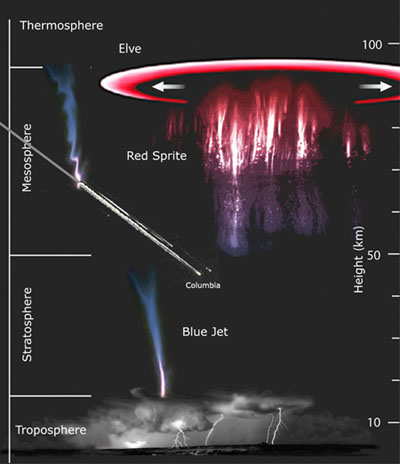|
by Michael E. Salla, Ph.D
According to David Sereda, who conducted the photographic analysis, the length of the five exposures conclusively show that it was not a form of 'super' lightning that hit the Columbia, but an advanced plasma beam weapon of some kind.
Sereda documented his analysis in a recently released video, From Here to Andromeda, extracts of which were uploaded this week to YouTube (below video).
The series of five photos were originally submitted to NASA to help it in its investigation of the Columbia tragedy by the astronomer who chose to remain anonymous. His submission of the photos to NASA was covered by a reporter from the San Francisco Chronicle and appeared in a story on February 5, 2003.
The reporter claimed:
NASA responded to the photographs by claiming that the lightning was an artifact from camera wobble despite the camera being on a tripod and showing features of the shuttle clearly.
According to one researcher:
The apparent lighting strike did not figure in
NASA's official
explanation that the Columbia crash was due to a tile being
dislodged at launch that damaged the leading edge of the left wing
and the thermal insulation system, causing the Columbia to
disintegrate during re-entry.
The scientist nevertheless concluded:
While such an explanation enjoys support from a few scientists promoting an electrical model of the universe, it is not supported by NASA or most scientists who view lightning as being discharged from the upper atmosphere downwards towards the Earth, rather than in the ionosphere which was the altitude (63 kms) where the Columbia was photographed.
Furthermore, there was no
lightning activity appearing below the Columbia as it was
descending, helping to eliminate mainstream scientific support for
the theory that a rare form of mega-lightning hit the Columbia.
Sereda argues that the five still photographs span a total of thirty seconds showing the purple lighting strike corkscrewing as it zeroes in on the tail end of the Columbia for the final dramatic hit. A graphic depicting the trajectory of the Columbia when it was hit by a 'lightning bolt' with an accompanying analysis (click above image for source).
According to Sereda, lighting typically discharges in a fraction of a second. It does not span the thirty second period observed in the five photos shortly before the Columbia crashed.
Consequently, Sereda concludes that it was not 'super' lightning that hit the Columbia in a freak collision, but an advanced plasma weapon.
Sereda (and other researchers in a second video - watch it below) then go on to discuss whether the plasma weapon was fired by extraterrestrial vehicles engaging in some kind of ET vs. ET, or ET vs. secret governmental conflict.
In either case, the Columbia was the victim in an undisclosed war by space faring entities with advanced plasma weapons.
In my very first Exopolitics Comment on Feb 2, 2003, I had proposed that the Columbia was shot down as a result of a conflict between different factions of the secret government over the Bush administration's Iraq policy.
This is what I wrote at the time:
Given the photographic evidence conclusively showing that Columbia was hit by a bolt of lighting, the real question is whether the lighting bolt was a freak plasma discharge from the ionosphere, as supporters of the electrical universe model claim, or resulted from a plasma beam weapon. Since there was no thunderstorm activity observed below Columbia, and due to the long 30 second period of the plasma discharge, the evidence supports Sereda's conclusion.
As to the question of whether plasma beam weapons are real, research conducted by Dr Douglas Beason shows the feasibility and practicality of Directed Energy Weapons in open source literature.
Furthermore, video analysis of the 1991 STS-48 mission, shows what appears to be a plasma beam weapon targeted at a UFO.
Whatever the ultimate explanation, it is important for the general public to learn about,
The idea of
space based wars is no
longer a fiction, but is an undisclosed reality of the early 21st
Century.
|

